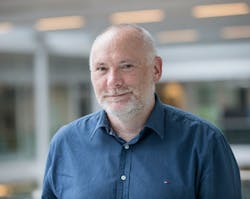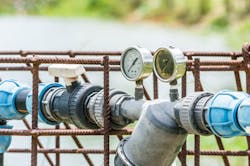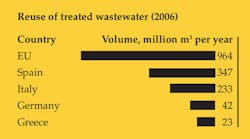Water Reuse - It's Time to Wake Europe's Sleeping Giant
A new industry association hopes to put Europe on the map when it comes to reusing wastewater. Paul Jeffrey, chair of WaterReuse Europe discusses why there is a need for more collaboration in this area.
By Tom Freyberg
When the news emerged that a new association was being launched in the water industry, many industry professionals might have thought ‘not another one’. With the International Water Association, Water Environment Federation, International Desalination Association, as well as many local industry bodies, it could be said that a plethora of associations already exists. Yet Professor Paul Jeffrey, chairman of WaterReuse Europe (WRE) believes there is a gap in the market.
“There is a lot of work to undertake but there hasn’t been to date any central point of reference for all those initiatives,” he says, discussing the potential for water reuse in Europe.
“I think there’s not been enough focused activity from the other associations. Our unique niche is that we are purely focused on reuse. There are other topics we would be keen to support, such as the role of water reuse in the circular economy.”
The opportunity to start WRE came about through a research project funded through the Seventh Framework Project (FP7) by the European Commission. This was called DEMOWARE in short, or “Innovation Demonstration for a Competitive and Innovative European Water Reuse Sector, in full. This came to an end on December 31st 2016. As part of the project, the industry association was set up to help drive water reuse across Europe. A board of directors was set up comprising seven industrial partners. This includes Philippe Bréant, projects director at Veolia Research & Innovation.
Driving membership
At the time of writing WRE has recruited 15 members, including large water utilities, to consultancies, equipment manufacturers and solutions providers. It says it has received membership applications for 27 organisations.
Jeffrey, the professor of water management at Cranfield Water Science Institute, indicates the potential membership size.
“When we were setting up the association the first thing we did was to look at what the potential membership size was,” he says. “We identified over 400 companies across Europe that have an explicit interest in water reuse. Getting 100% of those companies would be fantastic. Those organisations will have different preferences on what they need and we can’t do everything during the early days when we’re quite small.”
Multiple stakeholders are involved in water reuse. Utilities are at the coal face physically implementing it, often with technical support from consultancies. Meanwhile manufacturers provide the equipment necessary to do so. All of this is driven by regulation, which is shaped using academic research and advice. The goal of each stakeholder varies widely. A manufacture will want to sell its equipment, whether screens or membranes. Meanwhile a utility could require technical assistance or wish to hear other utilities’ success or, more importantly, failures. This raises the question, therefore, of how a single organisation can cater to the needs of so many different individuals?
“I’m very keen that we continue to collect that eclectic mix of members,” says the WRE chairman. “I don’t want to just serve the large multinational companies, or on the other hand just service the small technology manufacturers. I think the future for WaterReuse Europe is to provide a common home for any organisation that’s interested in and involved in the water reuse sector.”
With the funding from the European Commission finishing at the end of 2016, WRE had to, in Jeffrey’s words, be “self-sufficient”.
“The income from membership fees will be one of a number of income streams we’ll have access to but certainly in the first year or two that will be the most important,” he adds. “It’s also a useful test on the attractiveness of the association – if we can’t attract members then we have to be a bit reflective and ask ourselves have we started something that people have an appetite for and is needed? Thankfully the response to date has been positive. We do need that membership base to grow pretty rapidly to retain our financial stability.”
Currently the association can offer a database of over 700 scientific papers and reuse project data to its members yet its mission statement, at this stage, remains purposefully open and flexible.
“In terms of how it plays out to members, we are a member driven organisation – we don’t have an agenda without the interest of our members. Early this year we will ask our members for their ideas on the type of services they should be offering.”
Like just water itself, the association will be fluid and take the shape of what its members need.
Putting Europe on the map
European countries are rarely cited when it comes to successful examples of water reuse. Singapore’s NEWater story – cleaning up municipal wastewater and blending it with existing reservoir supplies – is often quoted. A recently opened fifth wastewater reclamation plant means that NEWater can now meet 40% of Singapore’s total daily water demand. By 2060 this will jump to 55% of total demand. In the future, the island nation will meet more than half of its water demands by recycling existing supplies.
Meanwhile, Israel has a respectable reuse rate of nearly 90%, with farmers reportedly competing over cleaned up effluent for irrigation. And Abu Dhabi is set to collect and reuse 100% of its wastewater by 2019. So will WRE help put Europe on the global reuse map?
“Water reuse is something of a sleeping giant in Europe – the potential is huge,” says Jeffrey enthusiastically. “I’m not for one minute suggesting reuse is always the solution – it is one important component of any sustainable water management strategy. It has to be in the mix in terms of being an option.”
So what has held back reuse across the continent before?
“My feeling is that it is often not taking seriously enough for a number of good reasons – some of them are to with core understanding of the science behind the technology sometimes,” adds the professor. “Often the reasons might be around nervousness around public responses to reuse schemes. Some of that nervousness is around the cost of reuse schemes. If we look at those examples in Australia and Singapore, we can see these are hurdles and not barriers.”
Jeffrey says critics often say that in places such as Singapore and Australia, there’s a greater need driving water reuse. This is due to the water scarcity index being a lot higher than in Europe.
“There are just as many counter examples, where in reasonable water rich environments a water reuse scheme makes cost and environmental sense.”
Future plans
The organisation has its first conference and exhibition organised in Brussels in October. A series of smaller, regional workshops is also being developed.
“I’ve been involved in research on water reuse for almost 20 years,” says Jeffrey. “The one truism I’ve picked up from that time is that each set of circumstances for water reuse are unique. It’s very dependent on what the source water is, what you intend to use the water for, what your technology options are, what local circumstances are. Those global figures about cost are averages and are encouraging but the devil is always in the detail on reuse schemes.”
With the European Commission funding now finished, WRE has to stand on its own financial feet and continue to grow its membership. Whether it can obtain 100% of its target 400 members is a separate question. The organisation has entered an already busy market of associations, which will want to protect their memberships. However, the timing of WRE could not be better; the theme of this year’s World Water Day is water reuse.
Asia and the Middle East have established their water reuse heroes. Here’s wishing, under Professor Jeffrey’s leadership, WRE can do the same for Europe.
Tom Freyberg is chief editor of WWI magazine. The full video interview is available online: www.waterworld.com.
Water reuse across Europe
Official information on water reuse across Europe dates all the way back to 2006. Surprisingly, no data is available on the current volume of treated wastewater being reused in the EU. However, a previous study to support the impact assessment estimated current volumes at 0.4% of annual EU freshwater. In 2006, Spain and Italy accounted for 60% of the total EU wastewater reuse volume. Cyprus and Malta have also achieved 89% and 60%, respectively, in water reuse although it should be noted that volumes are much lower.
Membership Structure
Categories for joining WRE include:
- C1 - Commercial companies involved in the water reuse sector (e.g. water services companies, equipment providers, consultancies, etc.).
- C2 - Public bodies involved in water reuse (e.g. regulators, publicly owned water supply bodies);
- C3 - Universities / Research Centres;
- C4 - Trade & professional associations (local, national, international).
Membership costs range from €185 for trade/professional associations, through to €6,150 for commercial companies with a turnover above €12 million.
More Water & WasteWater International Archives Issue Articles
About the Author

Tom Freyberg
Tom Freyberg is an experienced environmental journalist, having worked across a variety of business-to-business titles. Since joining Pennwell in 2010, he has been influential in developing international partnerships for the water brand and has overseen digital developments, including 360 degree video case studies. He has interviewed high level figures, including NYSE CEO’s and Environmental Ministers. A known figure in the global water industry, Tom has chaired and spoken at conferences around the world, from Helsinki, to London and Singapore. An English graduate from Exeter University, Tom completed his PMA journalism training in London.




